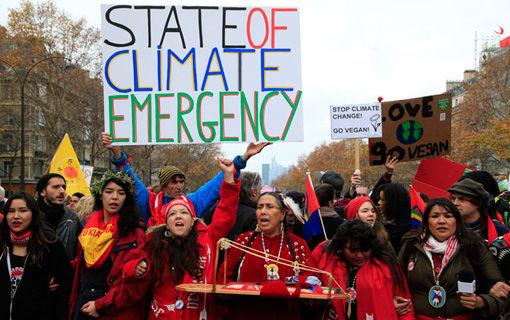
Many studies and writings about climate change discuss the essential tipping points for hospitable human life on earth, sometimes referred to as planetary boundaries. These range from the level of greenhouse gases in the atmosphere to ozone levels to ocean acidification. Some studies propose nine, others break it up a bit differently.
Many scientists argue that humanity has already forced nature to pass four of these tipping points – some, especially the level of greenhouse gases in the atmosphere (now consistently over 400 ppm), by a wide margin.
Other discussions of tipping points are geared to limits that we must not exceed without causing damage we can’t recover from. For example, due to global warming, the Arctic is heating up at a rate about four times that of the world as a whole. That affects the massive areas of permafrost across the top of the northern hemisphere. Within that permafrost, much of it frozen for tens of thousands of years, are buried billions of tons of organic material that once defrosted will release massive amounts of carbon dioxide and methane – enough to potentially overwhelm all human efforts to limit greenhouse gas emissions. We don’t know with precision where the exact tipping point is which will result in this runaway train of emissions, but we certainly don’t want to find out by crossing it.
While this approach still has many unknown variables and uncertainties, it offers a framework to understand the whole range of environmental crises that humanity faces. Climate change is in some ways the most basic, and in other ways the most crucial because it makes all the other environmental crises worse. But climate change, as the planetary boundaries framework makes clear, is not the only serious and potentially deadly to humanity environmental threat we face. We have to meet many challenges on many fronts to address the imbalance between how humans create the energy which enables developed human existence on the one hand, and the needs of nature upon which humanity depends in even more fundamental ways. We need water and air, and there is no other “product” which can be substituted if they become completely polluted with toxic substances.
Some commentators wish to frame these boundaries as opportunities. They point to spectacular growth in sustainable, renewable energy, and to many other technological advances being made.
However, there is an even more crucial tipping point that has been ignored – environmental movement tipping points.
Environmental movements have the sentiment of billions of people, though the actual organizations and the specific campaigns have been confined to much smaller groups. But the environmental movement and the other organizations and movements it allies itself with are reaching a crucial tipping point.
Millions have taken to the streets in many demonstrations around the world over the last several years, from the Peoples Climate March in September 2014 to innumerable smaller local marches on local environmental issues. Demands to “Keep It in the Ground” and to divest from fossil fuel corporations have taken root and are spreading. Major sections of the proposed Keystone XL pipeline have been stopped by President Obama, following years of demonstrations, petitions, and creative acts of opposition. These movements played a big role in forcing the UN COP20 Conference in Paris last December to reach an unprecedented worldwide agreement, limited and inadequate though it was. And more is being planned for this year.
Issues of climate change and environmental policy will certainly play a role in the elections this fall. All the Republican contenders for their party’s nomination reject climate change. Both Democratic candidates offer themselves as ready to take on the tasks of addressing how to slow climate change. All the Republican candidates want to eliminate or handcuff the Environmental Protection Agency, and the Democratic candidates want to strengthen it. Bernie Sanders spoke out early against the Keystone XL pipeline, forcing Clinton to join him in urging Obama to reject it, which he did. These conflicts will be one test of how close to a U.S. political tipping point we are.
Though many species are becoming extinct or having their habitat reduced or destroyed, it will take human action to fix the problem. For example, polar bears are “canaries in the coal mine” for global warming. However, we can’t organize the polar bears to stop global warming – that will take organizing people.
The problem was created, at least in large part, by people, and only people can make the necessary changes. But it is really not people in general: It is the economic system within which people function – capitalism. Capitalism is based on a paradigm of infinite economic growth, but we live in a world which is finite. These two facts come into conflict. Furthermore, capitalism is based on capitalists paying as little as possible for the production which creates their profits, and that leads most of them and their managers to ignore the needs of nature to be able to reproduce itself.
So to the 9 Planetary Tipping Points, I propose we add as a counterweight the Environmental Movement Tipping Point, the event horizon which will signal a movement large enough, united enough, and militant enough to challenge the system which is creating or exacerbating the many environmental crises we face.
Photo: AP












Comments